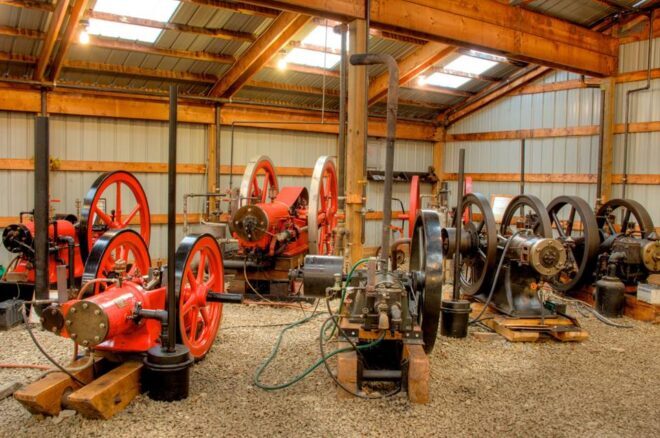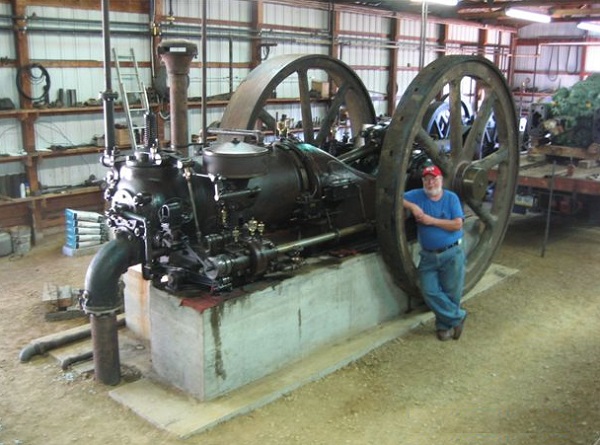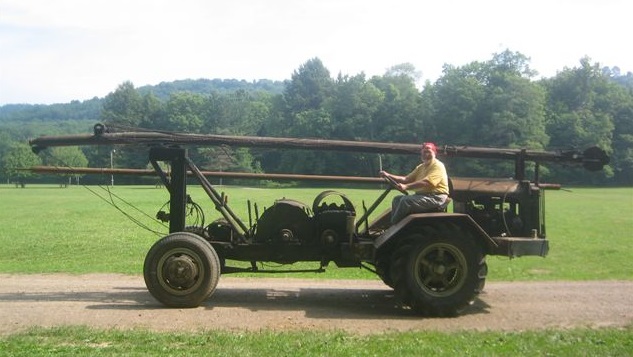Cool Coolspring Power Museum
Western Pennsylvania collection of engines preserves a remarkable history of powering America.
Vintage oilfield engine exhibits are part of an unusual Pennsylvania museum in the rustic hills of Pennsylvania near Little Sandy Creek, just off Colonel Drake Highway 36, about 10 miles northwest of Punxsutawney.
Indoor and outdoor displays of rare engines, many carefully restored and maintained by volunteers, educate visitors about the 19th-century evolution of internal combustion technologies that helped end the age of steam.

The Coolspring Power Museum opened in 1985 near Punxsutawney, Pennsylvania. It has the largest collection of historically significant stationary gas engines in the country, if not the world. Photo courtesy Coolspring Power Museum.
The Cool Spring Power Museum, which opened in 1985, exists thanks to its long-time director who spent decades collecting and preserving hundreds of engines of all shapes and sizes. In a 2004 interview, Dr. Paul E. Harvey explained why the collection was important.
“Internal combustion engines revolutionized the world around the turn of the 20th century in much the same way that steam engines did a century before,” noted Dr. Harvey, who co-founded the museum in 1985 about midway between Punxsutawney and Brookville, Pennsylvania.
“One has only to imagine a coal-fired, steam-powered, airplane to realize how important internal combustion was to the industrialized world,” added Dr. Harvey, a medical doctor.

The museum hosts many summer events, including a “History Day and Car, Truck & Tractor Show.” Photo by Bruce Wells.
According to Dr. Harvey, permanent exhibits at Coolspring include stationary gas “hit and miss” engines, throttle-governed engines, flame ignition engines, hot tube ignition engines, and hot air engines ranging in size from a fractional horsepower up to 600 horsepower.
Many engine enthusiasts from around the country have sent significant pieces for display, he said. The grounds, as well as semi-annual shows, have expanded with visitors from Maine to California, as well as Canada and England.
Dr. Harvey explained that early internal combustion engines produced only a few horsepower and could not replace steam engines in most applications, but by 1890 they were powerful enough for most portable or remote operations as well as many small manufacturers.
By 1900 the new power technology was replacing reciprocating steam engines for electric generation, Dr. Harvey noted. “By 1915 they were being considered for all but the largest installations where steam turbines have since dominated,” he added. Dr. Harvey and fellow enthusiast John Wilcox began collecting engines in the 1950s. Their collections were the basis of displays that would greatly multiply.
The museum is housed in 20 buildings that, besides its own large collection, contain many pieces placed there on loan. Dr. Harvey said the purpose of Coolspring was “to be the foremost collection of early internal combustion technology presented in an educational and visitor-oriented manner and to provide an operation that will gain support and generate substantial growth.”

Dr. Paul Harvey, co-founder of the Coolspring Power Museum in Pennsylvania, next to a 175 HP Otto engine he restored with help of museum volunteers. Photo courtesy the Coolspring Power Museum.
The collection documents the early history of the internal combustion revolution. Almost all of the critical components of today’s engines have their origins in the period represented by the collection (as well as hundreds of innovations no longer used). Some of the engines represent real engineering progress; others are more the product of inventive minds avoiding previous patents. All tell a story.
Although the museum’s focus is on stationary engines (with perhaps the largest collection anywhere), Dr. Harvey explained that no museum of internal combustion engines would be complete without at least a few vehicles in its collection. Among the antique heavy trucks and semis, is a rare petroleum well service rig.
The Hanley & Bird Well Bailing Machine was designed to clean a well by lifting water, sand, and debris from the bottom of the well using a “bailer” attached to a cable, noted the museum director.

A “last of its kind” Hanley & Bird Well Bailing Machine from the Pennsylvania oilfields. Photo courtesy Coolspring Power Museum.
Five of the devices were built; the Coolspring Power Museum’s example is the only one to survive. “It was donated to the museum by EXCO Resources, the successor to H&B,” Dr. Harvey said. “It is very interesting as it uses a chain drive Mack rear end and a Ford front axle.”
Dr. Harvey recalled seeing the Hanley & Bird Well Bailing Machine driving through Coolspring on its way to service local natural gas wells. He said that the museum today displays it with the mast raised and ready to work. “It certainly shows the ingenuity of the local gas industry,” he reported.
The Coolspring Power Museum collection includes many engines used to power multiple wells in America’s first oilfields. The museum is off Route 36 midway between Punxsutawney and Brookville in western Pennsylvania.
As the steam engines revolutionized the world in the 1800s, the internal combustion engines on exhibit at the Coolspring Power Museum did the same at the start of the 20th century, according to Dr. Harvey.
“You have only to imagine a coal-fired, steam-powered, airplane to realize how important internal combustion was to the industrialized world,” the doctor added with a chuckle.
The Coolspring Power Museum hosts events in the spring and summer, including the History Day and Car, Truck & Tractor Show. The 2024 Spring Exposition included the museum bringing back its popular late 19th-century Foos Gas Engine Company gasoline engine (with timed fuel injection rather than a carburetor) and noting, “Foos was a very successful engine builder of a variety of types and sizes of efficient engines.”
_______________________
Recommended Reading: Around Titusville, Pa., Images of America (2004); Myth, Legend, Reality: Edwin Laurentine Drake and the Early Oil Industry
(2009); Oil on the Brain: Petroleum’s Long, Strange Trip to Your Tank
(2008); A History of the New York International Auto Show: 1900-2000
(2000). Your Amazon purchase benefits the American Oil & Gas Historical Society. As an Amazon Associate, AOGHS earns a commission from qualifying purchases.
_______________________
The American Oil & Gas Historical Society (AOGHS) preserves U.S. petroleum history. Please become an AOGHS annual supporter and help maintain this website and expand historical research. For more information, contact bawells@aoghs.org. Copyright © 2024 Bruce A. Wells. All rights reserved.
Citation Information: Article Title: “Cool Coolspring Power Museum.” Authors: B.A. Wells and K.L. Wells. Website Name: American Oil & Gas Historical Society. URL: https://aoghs.org/energy-education-resources/cool-coolspring-power-museum. Last Updated: September 30, 2024. Original Published Date: September 1, 2005.
.



